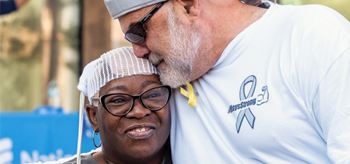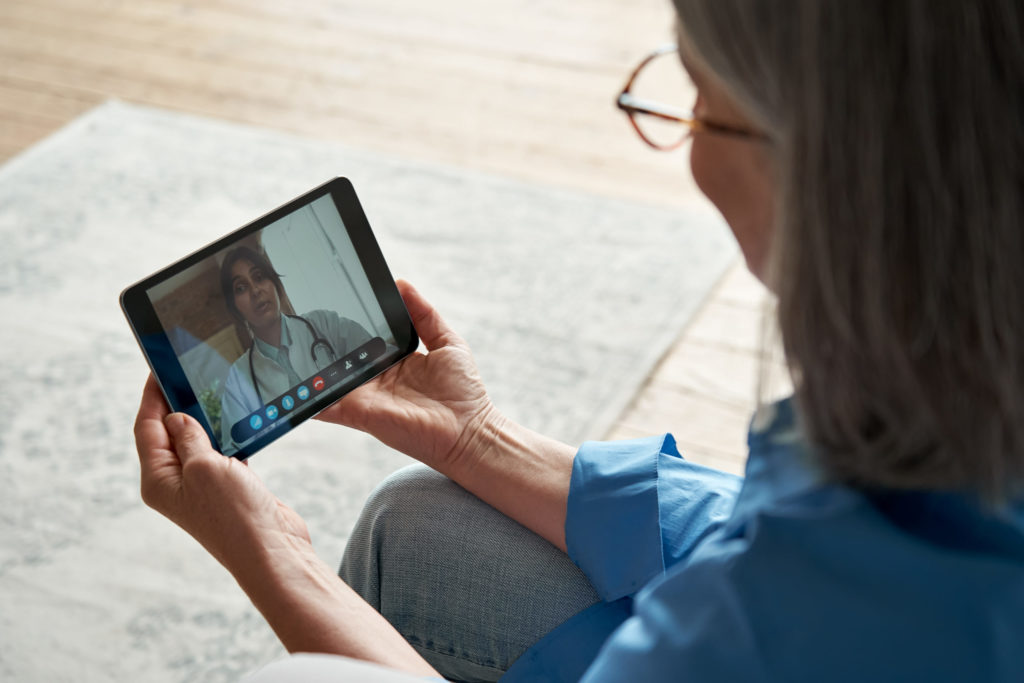On July 24, 2020, NBTS hosted a virtual Research Roundtable to determine what changes brought on by COVID-19 may actually benefit brain tumor clinical trials now and in the future.
“We brought together experts from neuro-oncology clinical research, biopharmaceutical and medical technology companies, the Food and Drug Administration, National Institutes of Health, and importantly patients and patient advocates to delve into the details of barriers and opportunities to leverage the virtual environment to keep clinical trials going and improve them for patients and the family members and friends who support them,” said NBTS CEO David Arons.
The meeting, led by Drs. Eudocia Lee and Wen from Dana Farber Cancer Institute, resulted in a new paper in the journal Neuro-Oncology that chronicles key takeaways and offers actionable insights and next steps that the brain tumor field can use to improve clinical trials in the long term.
What COVID-19 Taught Us
As the pandemic took hold across the country, hospitals and cancer centers quickly shifted to virtual appointments and made adjustments to ensure the safety of patients and clinical staff during routine care visits and clinical trials. Some procedures such as basic lab work (e.g., blood tests), and even some medical imaging appointments that otherwise would have been conducted at a main trial site were moved to local settings in patients’ own communities. And, when permitted, FDA-approved study drugs were shipped to local physicians or pharmacies for patients.
A number of policies were put in place by government agencies like the FDA, NCI, and the U.S. Centers for Medicare & Medicaid Services (CMS) to offer more flexibility to patients and those conducting clinical trials. These included waivers that permitted easier access to telemedicine, as well as guidance from the FDA and NCI on how to conduct health care visits and clinical trials in this new world of “decentralized” (trials using telemedicine, mobile or local health care provider, and/or mobile technology) or “hybrid” (combination of traditional and decentralized) trials, without compromising patient safety or the integrity of the data needed to evaluate potential new treatments.
As a result, rapid adoption of telehealth took hold, with some cancer centers reporting that almost two-thirds of follow-up care was conducted virtually.
Advantages of Decentralized/Hybrid Trials Using Telemedicine
Decentralized and hybrid trials were found to offer a potentially more patient-friendly setting and minimize some potential barriers to participation in trials. The main advantages to patients were found to include:
- Saving on time for patients otherwise needing to travel long distances to get to major cancer centers or hospitals that traditionally offer clinical trial options
- Saving on transportation costs (including parking, gas, plane/bus/train/cab fares, etc.), especially in cases where driving privileges have been restricted due to seizures
- Less time spent away from family, and distant family members can participate in follow-up visits to help make decisions alongside patients with cognitive limitations
- Less time spent away from work for patients (if the patient is still able to work) and caregivers
- Receiving treatment in a more familiar, comfortable environment
The ability to shift trials to a decentralized or hybrid model, making use of new technology and telehealth, would increase the ability for more patients from diverse backgrounds, different financial means, and in more rural areas to have more options to access cutting-edge trials, regardless of location.
Remaining Challenges
While COVID-19 has highlighted areas that can be improved to help make clinical trials more accessible for a greater number of patients, the NBTS roundtable identified a number of barriers that require continued attention. These include issues related to:
- Continued health insurance reimbursement policies for telehealth
- Issues related to cross-state licensing of doctors and medical providers to further facilitate telehealth (i.e., the ability for clinicians to see patients in different states that they aren’t licensed to practice medicine in)
- Issues related to policies regarding the shipping of drugs across state lines
- The ability for trial leaders to find qualified health care providers in the community that have the authorization, technology, and expertise to conduct the necessary procedures related to a trial (e.g., MRI scans, lab work, etc.)
- The ability to harness technology for aspects of trials like signing informed consent waivers or exams that are traditionally done in-person at the main trial center.
Finally, it was noted that although telehealth offers tremendous opportunities to make life easier for patients, it does also carry the risk of potentially exacerbating existing disparities in treatment. For example, telemedicine is often less accessible to racial and ethnic minorities, patients with limited English proficiency, those with lower incomes, and those who are elderly or have physical or cognitive deficits. Patients with low digital literacy who live alone and cannot operate the technology and resources needed for telemedicine without assistance are also at a disadvantage. These disparities can be compounded by limited access to broadband or high-speed internet and related technologies. All actions to improve access to clinical trials must ensure there are no unintended consequences that harm already disadvantaged groups.
A Path Forward
To advance a vision of decentralized or hybrid trials becoming the “new normal” for brain tumor patients, the group determined action items for researchers, clinicians, and patient advocacy organizations to take in order to combat these challenges.
Policy issues that impact the larger health care system
Issues such as cross-state medical licensing, cross-state distribution of drugs, and continued health insurance reimbursement for telemedicine are problems that many across the health and medical landscape are interested in solving. As a patient advocacy organization, NBTS is already working with partners in different disease areas to address some of these policy issues. For example, at our recent Head to the Hill advocacy day, one of our asks of Congress was to support the Telehealth Modernization Act, legislation that would extend, expand and make permanent many of the policies that allowed telehealth to flourish during the COVID-19 pandemic. Similarly, policies should be put in place to ensure that disadvantaged patients have access to medical interpreters who can assist them in an era of increased telemedicine.
Issues specific to the brain tumor community
The brain tumor field will need to determine what specific aspects of brain tumor clinical trials (which may vary by type and phase of trial) need to be done at a central trial site versus what can be accomplished remotely or in the community provider setting. For aspects of trials that can be accomplished in a decentralized setting, to ensure rigor and reliability, it is important that the field:
- Develop or refine a standard approach to conducting neurological exams via video calls, that can be shared with the field and widely adopted. The group believed that the standard test used in the field, called NANO (Neurologic Assessment in Neuro-Oncology) could likely be modified to be performed remotely by video, particularly if there is assistance from a caregiver or family member.
- Promote the adoption of the Brain Tumor Imaging Protocol, which NBTS and many of the same leaders behind this workshop helped develop in 2015 to standardize imaging captured and used during clinical trials.
- Determine a core set of criteria, capabilities, and expertise needed for community health care providers to participate fully as trial partners. The group also believed that community practitioners and providers could be identified by engaging with national organizations and existing networks like the NCI’s Community Oncology Program.
The COVID-19 pandemic has created a major disruption in the traditional approach to brain tumor clinical trials, leading to enhanced regulatory and sponsor flexibility and the opportunity for innovation. Telehealth and telemedicine trends, emerging prior to the pandemic, have been exposed as new opportunities that can be carefully leveraged to improve the patient experience in the long term.
Titled, “Report of the National Brain Tumor Society Roundtable Workshop on Innovating Brain Tumor Clinical Trials: Building on Lessons Learned from the COVID-19 Experience,” the paper explores the potential silver linings of the changes the pandemic has wrought, with Drs. Lee and Wen, Mr. Arons, and NBTS’s Research Program Administrator Clair Meehan among the authors.
NBTS thanks Drs. Lee, Wen, Amy Barone, Erik Bloomquist, Susan Chang, John de Groot, Eva Galanis, Islam Hassan, Chitkala Kalidas, Mustafa Khasraw, Mark Kieran, Joseph Kvedar, Andrew Lassman, Vinay Puduvalli, Solmaz Sahebjam, Lee Schwamm, Sharon Tamir, Mary Welch, Alfred Yung, and Gelareh Zadeh, for their support and partnership in shaping the meeting and subsequent paper, as well as Wendy Selig, Jeffrey Bacha, and Sharon Tamir.
For a more comprehensive list of ALL open brain tumor clinical trials, visit the NBTS Clinical Trial Finder, where you can search potential opportunities for enrollment based on criteria important and specific to you.
For additional navigation support, you can access NBTS’s Personalized Support and Navigation program by emailing patientnavigator@braintumor.org. Our patient navigator, Mary Lovely, PhD, RN, CNRN, has more than 30 years of experience working closely with brain tumor patients and families as a neurological nurse, clinical nurse specialist, and research nurse.
> Learn more



